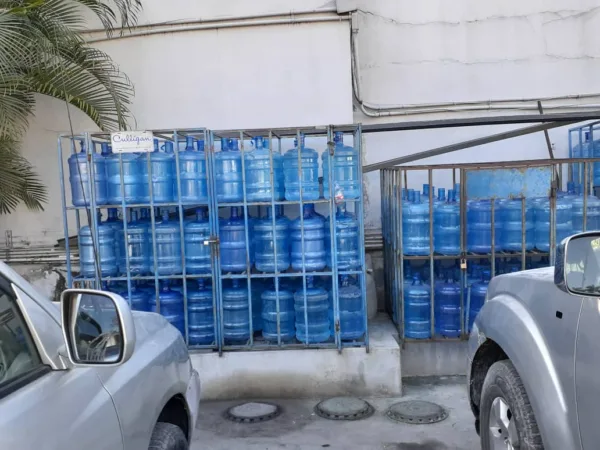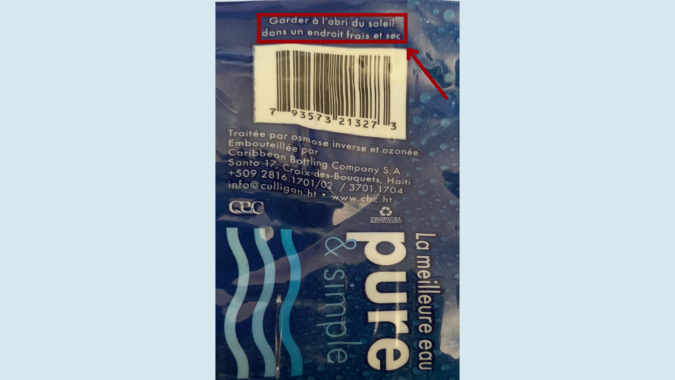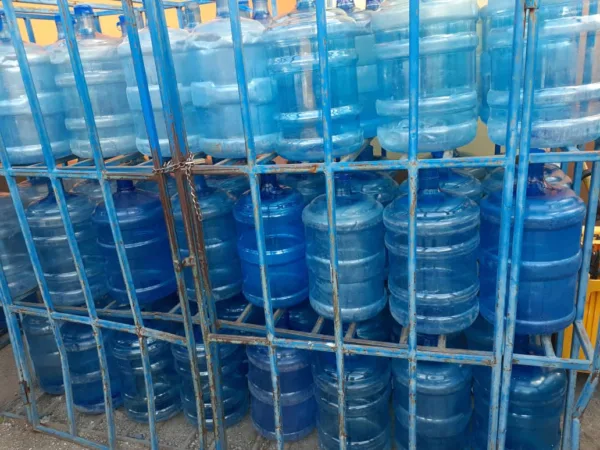Improper water storage contributes to plastic degradation and the deterioration of water quality, scientific studies show
Supermarkets and gas stations in Haiti store gallon containers of treated water in the sun for relatively long periods of time, which can contribute to deteriorating water quality or promote the degradation of plastic. This practice therefore poses a risk to human health, according to two chemists and two managers at water production companies contacted by AyiboPost.
Continuously exposed to sunlight, plastic degrades and mixes with water at microscopic levels.

View from the Star Mart parking lot, on Martin Luther King Avenue in Nazon, containers of « treated » water exposed to the sun were observed on December 12, 2023. | Photo : Fenel Pélissier
According to a report from the Endocrine Society published on December 15, 2020, plastic containers contain products that can disrupt the hormonal system and cause cancer, diabetes, reproductive disorders and neurological impairments in fetuses and developing children.
Another study published on Monday, January 8, 2024 in the journal Proceedings of the National Academy of Sciences reveals an underestimate in the quantity of plastic particles present in bottled water sold in the United States.
Continuously exposed to sunlight, plastic degrades and mixes with water at microscopic levels.
The study shows that bottled water — depending on the quality of the container — could contain up to 100 times more plastic particles than previously estimated, because previous research only considered microplastics, or pieces between 1 and 5,000 micrometers.
A typical one-liter water bottle contains about 240,000 plastic fragments on average, according to the study. The nanoplastics found in these containers represent a greater threat to human health than microplastics because they are small enough to penetrate human cells, enter the bloodstream, and impact organs.
These nanoplastics — one micrometer in length, or one-sixtieth the width of a human hair — can pass through the placenta into the bodies of unborn babies.
Contacted by AyiboPost, Marie Emmanuelle Lahens, chemist and manager of the quality control laboratory at Caribbean Bottling Company (CBC), distributor of Culligan water, reiterated the need to store the company’s gallons of water “out of the sun, in a cool, dry place.”

Culligan Water Gallon Label
The company “Eau Alaska” also advises its distributors not to leave the gallons in the sun, according to Miché Saint-Jean, the marketing and collection manager. But, unlike Culligan, the company does not include the warning on its labels.

Containers of « treated » gallons of water stored in the sun at Olympic Market, in Lalue. | Photo: Fenel Pélissier
Ozone, a chemical compound used to disinfect water and kill its bacteria, naturally decomposes under prolonged exposure to sunlight. This gradually reduces its effectiveness and over time causes the proliferation of bacteria, making the water less clean.
“A gallon or bottle of water that contains ozone can last up to twelve months, depending on the date of production, without producing bacteria,” says Marie Emmanuelle Lahens, from Culligan. “But, continues the chemist, if a bottle of water is left in the sun for a long time, the ozone will disappear in the water and the preservation period will decrease.”
The European Bottled Water Federation, which represents more than 600 producers, published a guide in 2012 which recommends that professionals not store their products outside. But the structure considers storage acceptable if it is covered, in plastic film, and for a period of “less than 24 hours.”
The company “Eau Alaska” also advises its distributors not to leave gallons in the sun. But, unlike Culligan, the company does not include the warning on its labels.
The Quality Control and Consumer Protection Department (DCQPC) of the Ministry of Commerce does not have the resources to supervise water at points of sale, according to Willy Bien-Aimé, head of the DCQPC.
In fact, it is the entire water distribution chain that threatens the health of the population.
Read also: Practically no government oversight over the « treated water » sold in Haiti
According to 2016 data from the DCQPC, around fifty large and medium-sized water treatment companies and around 90 water resale kiosks are listed in the metropolitan area of Port-au-Prince. The Haitian State exercises almost no supervision over this sector.
The latest study carried out between 2014 and 2015 by the National Directorate of Drinking Water and Sanitation in the ten departments of the country shows that 68% of the 300 water sources used to supply the population were contaminated.

Containers of « treated » gallons of water stored in the sun at Olympic Market, in Lalue, on December 16, 2023. | Photo: Fenel Pélissier
In the case of wells and groundwater, 3% have physicochemical or chemical characteristics that may present health risks.
According to another World Bank report published in 2018, the services provided by the technical water exploitation centers (CTE) for water and sanitation services in urban areas — which are part of DINEPA — are also poor in quality.
In Port-au-Prince, for example, CTE clients are served an average of 26 hours per week, according to the report. In 20% of cases, the water samples tested do not meet official standards.
English translation by Sarah Jean.
Cover image: A person carrying water in a water-selling space.
Watch this report by AyiboPost on the pollution and contamination of groundwater in the Morne Hôpital area and in the city of Port-au-Prince, published in 2020:
Stay in touch with AyiboPost through :
► Our WhatsApp channel : click here
► Our WhatsApp Community : click here
► Our Telegram canal : click here







Comments